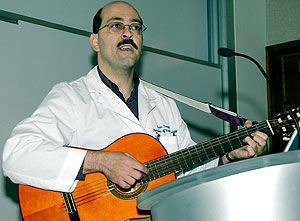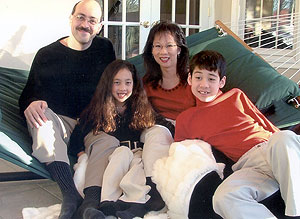It’s not likely many medical students can say they learned music appreciation in a neuropathology class — except for those in Arie Perry’s class.
Perry, M.D., associate professor of pathology and immunology in the School of Medicine, takes songs such as “Give Me One Reason,” “Desperado” and “Danny’s Song” and adds new lyrics to explain complicated neurological disorders such as oligodendroglioma, strokes and pituitary adenoma.

Students seem to anticipate the end of the lectures, when Perry pulls out his guitar and sings one of his songs on a lecture topic. He provides the lyrics and mp3 files to students so they can follow along.
“It’s fun for the students and fun for the professor as well,” Perry says. “I enjoy seeing people perk up, doing something other than hours of lectures.”
The soft-spoken Perry began writing songs about neuropathology as a resident at the University of Texas-Southwestern Medical School, when an attending physician at a conference jokingly challenged the residents to be more entertaining. Perry took it to heart and wrote his first song, “Schwannoma,” about the peripheral nerve tumor. By the end of his song, Perry had attracted two or three times more people into the room from those passing by who wanted to listen.
“Later on, when I began teaching medical students, I found the songs to be a useful tool for people with better musical memories than rote memories,” Perry says. “There are a lot of good musicians in medicine.”
When writing songs on neuropathology, Perry works to find several pieces that might fit the rhythm of the topic. “It’s a challenge to get the longer medical terms to fit into a preexisting format,” he says.
That rings true in the “Pituitary Adenoma” song, sung to the tune of “Danny’s Song,” recorded by Kenny Loggins in the 1970s:
“Patient presents to you with bitemporal hemianopsia
Prolonged amenorrhea, and galactorrhea
MR imaging reveals a sellar neoplasm, pushing up the optic chiasm,
From prolactin forming cytoplasm
Pituitary adenoma, with your disrupted reticulin stroma
You’ve lost the microacinar pattern of the normal gland
Your cells appear so monomorphic, with nuclei so round and perfect
And salt and pepper nuclear chromatin… ”
Perry, who has won several teaching awards — including the distinguished service teaching award from three classes and the professor of the year award from the Class of 2007 — says many of the songs he uses were popular before most of his students were born, which presents more of a challenge every year as students get younger. “But I hope that they enjoy it enough to look up the original,” he says.
Robert E. Schmidt, M.D., Ph.D., professor of pathology and immunology and director of the division of neuropathology at the School of Medicine, said he was surprised at first that Perry’s students had taken to the end-of-lecture songs.
However, he was soon convinced by the warm reception of Perry’s songs by normally intensely focused medical students.
One year, students even held up lighters, a typical rock concert gesture calling for an encore, during one of Perry’s songs, Schmidt said.
Perry’s musical background comes from taking folk guitar lessons while growing up. He also was the lead singer in a rock band in high school, in which he sang songs by The Who, Journey, Rush, The Beatles and ZZ Top. He also sang in the school choir and started taking voice lessons at that time, subsequently spending more of his efforts on classical music.
Perry and his wife, Zenobia, also a musician, sang their vows to each other at their 1990 wedding, which featured mostly original music.
These days, Perry also sings professionally as associate principal tenor for the American Kantorei and its Bach at the Sem series at Concordia Seminary in Clayton. He also sings solos with other St. Louis choirs or at weddings occasionally.
“I get more nervous at other peoples” weddings than I did at my own,” Perry says.
Zenobia Perry is the pianist at a local church and has recorded a CD of original music.

The musical talent continues in their daughter, Jaclyn, 10, who plays piano and participates in competitions. The Perrys also have a 13-year-old son, Ryan, who has autism and a good memory for lyrics, Perry says.
The Perry family is involved with the National Alliance for Autism Research, based in Princeton, N.J. Perry is on its executive committee for the Autism Tissue Program, which provides banked brain tissue from individuals with autism to researchers worldwide. Zenobia even wrote a theme song for one of the organization’s fund-raising walks.
The Jerusalem-born Perry and his family moved to the United States when he was 6 years old. His father, Gabriel Perry, an obstetrician-gynecologist, did a residency at Albert Einstein College of Medicine at Yeshiva University in New York. The family moved to Texas when Perry was 10.
Perry completed his undergraduate work at the University of Texas in 1986 and medical school at the University of Texas-Southwestern in 1990. He also did his residency at UT-Southwestern.
He did fellowships in surgical pathology and neuropathology and conducted research at the Mayo Clinic in Rochester, Minn., one of the premier tumor pathology programs nationwide, before arriving at Washington University in 1998.
Perry’s research focuses on tumors of the brain and central nervous system, which can be difficult to treat. He is involved in translational research aimed at finding new diagnostic, prognostic and predictive biomarkers to be used in managing brain tumor patients.
“It’s a complicated type of problem, and there are so many different types,” he says.
Some of his work during his fellowship at the Mayo Clinic resulted in new grading criteria for meningiomas, although commonly perceived to be benign overall, subsets are aggressive and clinically challenging tumors.
Those criteria have been adopted by the World Health Organization’s Tumors of the Nervous System publication, and are used as a reference for brain tumor diagnostic pathology around the world.
|
Arie Perry Title: Associate professor of pathology and immunology; medical director of the Anatomic Pathology Fluorescence in situ hybridization (FISH) lab Years at University: Eight Research interests: Tumors of the brain and central nervous system; finding new diagnostic and prognostic markers to be used in managing brain tumor patients Hobbies: Singing, writing songs, snow skiing, scuba diving |
Perry also is medical director of the Anatomic Pathology Fluorescence in situ hybridization (FISH) lab, which is used to identify clinically useful chromosomal abnormalities in a wide variety of tumors, most notably gliomas (a malignant type of primary brain tumor), breast cancer and subsets of lymphoma and soft tissue sarcoma.
“As a colleague, Arie is just what you’d want,” Schmidt said. “He’s an expert, who has a lot of drive and is a perfectionist. He also has a good sense of humor, which you have to have in this field.”
David H. Gutmann, M.D., Ph.D., the Donald O. Schnuck Family Professor of Neurology and professor of pediatrics and of genetics at the School of Medicine, said Perry is wonderful to work with and a valuable colleague.
“He has established himself as one of the rising stars in neuropathology,” said Gutmann, who also is the co-director of neurooncology at the Siteman Cancer Center and director of the Neurofibromatosis Center at the School of Medicine. “He is recognized internationally as an expert in brain tumors.”
Gutmann and Perry have collaborated for many years to refine their ability to genetically characterize brain tumors. Together, they hope to develop molecular signatures for brain tumors that might predict their responses to therapy.
In addition to his teaching and research, Perry provides consults for difficult surgical cases sent in from medical facilities, mostly throughout the United States and Canada, but also from other countries.
Schmidt said Perry is one of the best young tumor neropathologists in the country. “His burgeoning consult service reflects his growing reputation,” Schmidt said.
Although Perry doesn’t work directly with patients, he will often take a clinical problem back to the lab for research.
“It is still rewarding to know that you are helping the patient in something that will lead to the right management of the problem,” Perry says.